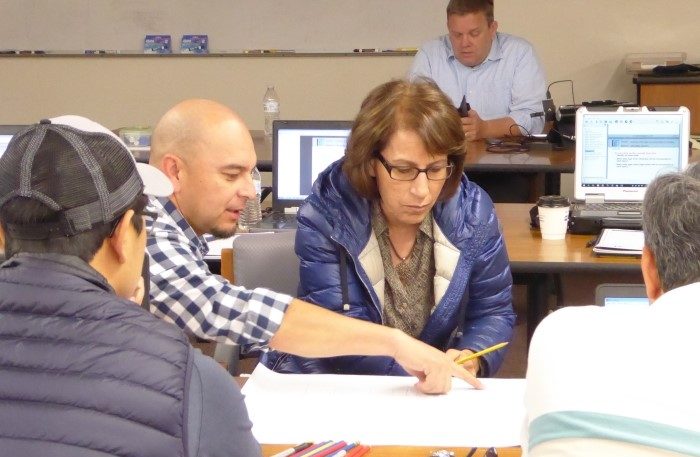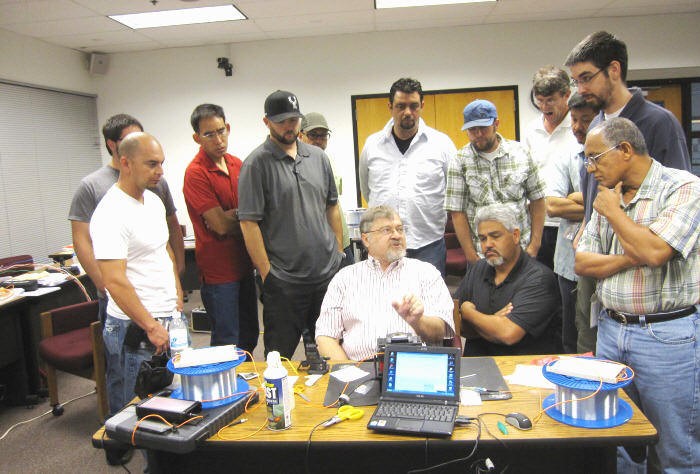

Professional Capacity Building (PCB), or workforce development, is a critical need for many departments of transportation. Along with the work of the COATS project and the Western States Forum that we shared with you in previous issues, the California Department of Transportation (Caltrans) recognized the challenges of maintaining a skilled workforce with the rapid advancements of ITS technologies and the complexity of rural transportation. Since 2008, WTI completed five phases of the Professional Capacity Building for Communications project for Caltrans.
To realize the full benefits of rural ITS on the transportation system, engineers, as well as technicians, must not only be aware of what technologies are available, but how to best select, implement, and maintain them. Due to challenges presented by rural ITS communications, Caltrans and the research team saw a clear need for an educational curriculum that addresses rural ITS communications engineering across the board with a hands-on approach by teaching underlying rural ITS engineering and design principles, available technologies, and practical applications for those technologies. To best present the curriculum, it should be taught by subject matter experts who can bring their own experiences and best practices into the classroom.
Over the last 15 years, the PCB project successfully addressed these challenges with an immediate and lasting impact. Needs assessments and gap analyses were conducted three separate times to develop a robust training curriculum and maintain its relevancy. Six training courses were developed: Radio Frequency Fundamentals, Radio Frequency (RF) System Design, Mastering Fiber Optic Network Design and Installation, Hands-On Ethernet and TCP/IP Fundamentals, Telecom Wireless Fundamentals, and Small Data Center Design, Structured Cabling, and Grounding. These courses are weeklong trainings (40 hours) with a minimum of 25% hands-on laboratory work/exercises and are taught by a subject matter expert with real-world experience. In addition, the project established quality syllabi and identified experienced instructors. This streamlined the Caltrans processes for training procurement, allowing more staff to be trained. Caltrans was also able to procure and deliver more advanced training from the same vendors and build off the original coursework. The breadth of content covered in these training courses is extensive, and yet practical, timely, and relevant to Caltrans transportation systems.
Over 300 students have been trained through the six original and 17 additional courses. The influence of this project is evident in student comments and testimonials:
Phil Graham was an electrical engineer in Caltrans District 9, which is headquartered in Bishop, and contains two counties in eastern California along the Nevada border. Arguably one of the more diverse Districts with respect to terrain, District 9 is very rural. Phil was a student in three of the Professional Capacity Building classes and what he learned allowed District 9 to make use of technology they may not have been able to otherwise, as well as make critical improvements to existing systems. Phil said:
“The training courses were quite helpful. The RF class helped expand my knowledge of wireless communication systems, which we use extensively. The fiber optic class was both timely and challenging, as my knowledge was quite limited and D9 is about to receive 6 dark fibers from the Digital 395 Project that runs for hundreds of miles through the heart of our District. I’m now able to design the systems that will be required for us to actually use these ‘free’ fibers.
The classes have helped build my technical knowledge but perhaps just as importantly, they have helped foster working relationships. The other help to me is to see that there are ITS practitioners that pioneer new ways to improve the state of the practice in spite of the obstacles.”
– Phil Graham, Transportation Engineer Electrical (retired), Caltrans District 9
Jeremiah Pearce is an ITS engineer and Chief of the Office of ITS Engineering and Support in Caltrans, District 2, in northern California. District 2 has been a leader in ITS deployments and a champion for many of the projects conducted through the Western States Rural Transportation Consortium. Jeremiah has sent staff and been a student or PTAP observer for most of the PCB for Communications courses and had this to say about his experiences:
“What I like most about the PCB classes is that they are hands on and delivered by industry experts. The learning and experience are invaluable. The fiber optic course was very useful as I was using information and techniques in the field within weeks of taking the class.”
– Jeremiah Pearce, Chief, Office of ITS Engineering and Support, Caltrans District 2
Check out how students are directly applying what they learned in the training courses to their job and read comments from students about the value of the PCB training courses on the project’s web page. You can also read about the different training courses and look through project reports.
The PCB for Communications project was extremely successful in workforce development for mission critical skills in ITS communications. Its impact has been immediate and will last into the future. The concepts, processes, and curriculum can serve as a model for other agencies as the transportation industry continues to address the challenges of maintaining a skilled workforce.
